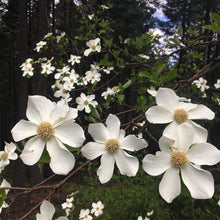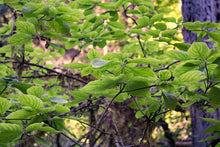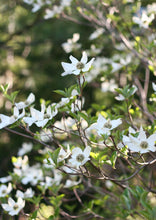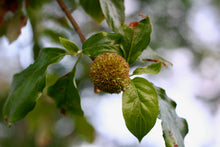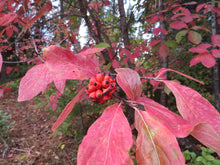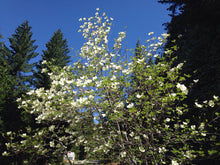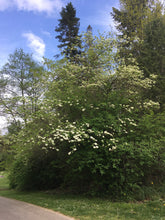
Cornus nuttallii
Western flowering dogwood, also known as pacific dogwood, is a highly ornamental small-to-mid-sized, deciduous tree that is loaded with habitat and ethnobotanical value. It is long-lived with an attractive upright form that can be single or multi-trunked. It bears bright green leaves and spectacular white spring “flowers”. By fall, the leaves put on a colorful show of pinks, oranges and even purple, while clusters of bright pink-red berries provide a feast for neighborhood birds.
We say “flowers” in parenthesis because the anatomy of a dogwood “flower” is exceptionally interesting. Contrary to popular belief, dogwood flowers are actually miniscule and greenish. Countless teensy-tiny flowers are clustered together into a small mound that most people think of as the center of the “flower”. The large, floppy white “petals” are actually over-sized bracts, which are the leaf-like structures that hold a flower. So, while many might say this lovely tree has large white flowers, in reality it has tiny greenish flowers, surrounded by exaggerated white bracts.
Note - This tree can be difficult to establish, is susceptible to anthracnose fungus and is sensitive to extreme heat events. With this in mind, it requires being planted in the right conditions (see below). Despite the hardship, many consider it worth the effort due to its extraordinary beauty and wildlife benefits.
- Plant type/canopy layer: deciduous, perennial, large tree
- Size at maturity: ancient wild specimens can be up to 80’ tall, though usually only 20 - 30’ in a garden setting; up to 25’ wide
- Light requirements: full shade to part sun/part shade
- Moisture requirements: moist to dry soils, requires well-drained
- Bloom time: March - July, may flower again in late summer
- Growth rate/ease: moderate growth rate, moderately difficult to grow
- Wildlife support: flowers attract and provide nectar to hummingbirds, adult butterflies, bees and other insect pollinators; leaves and young shoots are forage for deer and elk; berries are eaten by birds particularly Band-tailed Pigeons, flickers, Pileated Woodpeckers, grosbeaks, Cedar Waxwings, and woodpeckers as well as small mammals, beavers and even bears; overall plant provides nesting and roosting sites and it is believed to be a caterpillar host plant and larval food source for over 35 species of native butterflies and moths including the Dimorphic Bomolocha moth, the Fireworm moth, and the Fingered Dagger moth.
- Native habitat/range: relatively common growing in shaded moist, well-drained sites like open forests, mixed-forest slopes, forest edges and along streams, on both sides of the Cascade crest to the Pacific coast from British Columbia to California - plus a disjunctive population in northern Idaho. Portland Plant List - yes.
- Special features & uses: wildlife and pollinator favorite; attracts hummingbirds; indigenous peoples have long understood and used this plant best, the dried wood for harpoon shafts, bows, arrows, harpoons, cooking tools and more, while the boughs have been used in sweat houses, the bark as a tanning and dying agent, the charcoal to make tattoos, and the berries in ceremony; today the wood continues to be used for many things from thread spindles, to piano keys and golf club heads; medicinally a decoction of bark has been taken by indigenous people as a gastrointestinal aid, laxative, pulmonary aid, blood purifier, as well as as a purgative drug, an emetic, and a tonic; landscape uses include pollinator gardens, woodland gardens, erosion control, habitat hedgerows and windbreaks.
Gardening with Western Flowering Dogwood: This stunning tree is one of those species that is referred to as both easy and difficult to grow, depending on the resource. It all comes down to having the right conditions; full to part-shade sites, in soil that is moist, cool, deep, and high in organic matter with fast-drainage. In the wild, it thrives pressed up against the edge of a damp, mature forest among smaller companion plants, so as it matures it can reach its branches out for ample circulation. This species does not transplant exceptionally well, so transplant it once, very carefully, disturbing the roots as little as possible. Once planted, avoid disturbing the soil within a few feet of the trunk. Plan to provide deep/infrequent summer water for the first two-three summers until established, then do not irrigate again.
Dogwoods are also prone to anthracnose, a fungal leaf disease. Planting it in the right conditions, with good air circulation, and pruning it to an open branching pattern are the keys to reducing the chance of infection.
Photo Credit 1: © Matt Berger, some rights reserved (CC-BY)
Photo Credit 2: © Hilary Rose Dawson, some rights reserved (CC-BY)
Photo Credits 3 & 4: Karli Del Biondo, Beetles and Bees
Photo Credit 5: © Barbara Banfield, some rights reserved (CC-BY)
Photo Credit 6: © Ken-ichi Ueda, some rights reserved (CC-BY)
Photo Credit 7: © Harry Podschwit, some rights reserved (CC-BY)







